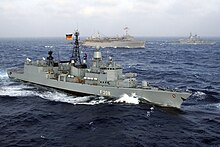Operation dragonfly
The operation dragonfly was the name of an operation of the armed forces in March 1997 in Albania , were flown to the German and other foreign citizens from Tirana. In the same week, US and Italian units also evacuated their citizens from Albania.
The exchange of fire during the evacuation in Tirana is described as the first battle by German soldiers since the Second World War .
Situation in Albania on March 13, 1997
Because of the unrest spreading over the country from the south, the so-called lottery uprising , the state order in Albania collapsed on March 13, 1997. Looting took place in the capital Tirana and the city's airport could no longer be reached. The foreign citizens remaining in the country were in acute danger.
The Foreign Office had asked all Germans in Albania on 11 March 1997 to leave the country. Italy had started to fly out foreign citizens. It was no longer possible to transport German citizens overland to the Adriatic coast on the morning of March 14, 1997. For them and for nationals of other nations in the care of the German embassy, all that remained was air evacuation. Because Allied forces were unable to provide support, the German government under Chancellor Helmut Kohl, after informing the parliamentary group leaders of the parties in the German Bundestag and the representatives of the Defense Committee , decided to have the evacuation operation carried out.
Course of the "Operation Libelle"
- March 13, 1997 - 8:45 p.m. Decision of Defense Minister Volker Rühe to improve the Bundeswehr's ability to react to relocate the Lower Saxony frigate (F 208) (210 crew members) to the sea area west of the city of Durrës (Albania).
- March 14, 1997
- Six transport helicopters of the type CH-53 G of GECONSFOR (L), the German contingent of SFOR (Stabilization Force) in Bosnia-Herzegovina with a command group, tank grenadiers as security soldiers and medical soldiers (89 soldiers in total) are relocated to Dubrovnik (Croatia).
- three transport aircraft of the type C-160 Transall are waiting around 7:00 a.m. in Landsberg (24 soldiers including 6 paramedics).
- At 7:30 am, German helicopters take off from SFOR's Rajlovac camp for Dubrovnik; the Lower Saxony is located in front of Durres.
- 11:35 a.m. Decision of the federal government to evacuate.
- 1:45 p.m. the German SFOR helicopters are relocated from Dubrovnik to Podgorica , the capital of Montenegro .
- 2:00 p.m. Departure of the C-160 Transall transport aircraft for Podgorica.
- 3:02 p.m. Departure of the helicopters with security forces (SFOR Panzer Grenadiers) to Tirana and landing at Lapraka airfield at 3:40 p.m. Around the landing zone, there is a fierce battle between unknown forces and Bundeswehr soldiers.
- 4:09 p.m. The last helicopter of the evacuation association leaves the capital Tirana.
Operation Dragonfly is complete. All citizens and German soldiers could be flown to Podgorica. During the operation, a helicopter was slightly damaged by fire. - 6:20 p.m. Departure of two Transall aircraft from Podgorica with the evacuees to Cologne / Bonn Airport . Arrival at 10:30 p.m.
- 19:42 Arrival of the last helicopter in Dubrovnik. The next day, return flight to Rajlovac.
The command of the task force had the later Brigadier General Henning Glawatz , at that time still in the rank of colonel , the commander of the airborne brigade 26 Saarland .
On March 18, 1997, the Federal Cabinet decided to forward the motion to the German Bundestag to approve the operation. On March 19, 1997, the relevant committees dealt with the motion, and on March 20, 1997 the German Bundestag approved this motion with a large majority.
Expelled people
A total of 98 people from 22 nations were flown out by the Bundeswehr:
| country | people |
|---|---|
|
|
21st |
|
|
14th |
|
|
13 |
|
|
11 |
|
|
5 |
|
|
3 |
|
|
3 |
|
|
3 |
|
|
2 |
|
|
2 |
|
|
2 |
|
|
2 |
|
|
2 |
|
|
2 |
|
|
1 |
|
|
1 |
|
|
1 |
|
|
1 |
|
|
1 |
|
|
1 |
|
|
1 |
|
|
1 |
aftermath
Although the emergency services were officially detached from the GECONSFOR operational unit and thus from the NATO Stabilization Force (SFOR) before the start of Operation Libelle and placed under national command, the Federal Ministry of Defense, similar to the one after Operation Pegasus , received an award for their work afterwards refused because the operation is said to have been a natural part of SFOR's mission in Bosnia and Herzegovina.
credentials
Individual evidence
- ↑ Operation "Dragonfly". Tirana '97: The Bundeswehr's first battle. In: rp -online. March 14, 2007, accessed on October 27, 2013 : "For the first time after the Second World War, German soldiers were in combat - they fired exactly 188 shots, according to the later accounts."
- ↑ bundestag.de
- ^ "Foreign business trip" to Libya on rp-online.de
Web links
- Bundeswehr: 20 years ago: Operation Libelle - evacuation from Albania (March 14, 2017)
- CNN report on Operation Dragonfly as of August 21, 2007
- AP report on the situation (archive, as of 1997)
- Excerpt from the ARD Tagesthemen from March 14, 1997. Note: Here we are talking about 103 evacuated Germans and foreigners and 91 men on the task force.
- Operation "Libelle" Tirana '97: The first battle of the Bundeswehr on rp-online.de March 14, 2007
literature
- Hans Krech (Ed.): The Civil War in Albania 1997. Verlag Dr. Köster, 2nd edition, Berlin 2000 ISBN 3-89574-280-5
- Martin Rink : Operation Libelle - The Evacuation of German Citizens from Albania on March 14, 1997 , in: Military History , Issue 1 (2007).


